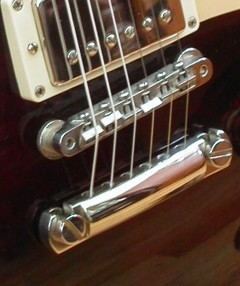 | ||
Tune-o-matic (also abbreviated to TOM) is a name of fixed bridge design for electric guitars. It was designed by Ted McCarty (Gibson Guitar Corporation president) and introduced in the Gibson Super 400 guitar in 1953 and the Les Paul Custom the following year. In 1955, it was used on the Gibson Les Paul Gold Top. It was gradually accepted as a standard on almost all Gibson fixed-bridge guitars, replacing the previous wrap-around bridge design, except on the budget series.
Contents
Function
Guitar strings, especially steel strings, are not ideal vibrators. Generally the thicker the string, the shorter the effective length. This refers to the length of string involved in producing a sound, as opposed to the length between the nut and the bridge. Many guitar designs with fixed bridges have the bridge slanted or stepped so that the distance from nut to bridge is larger for thick strings. The Tune-o-matic extends this idea to make the distance adjustable for all the strings, within limits.
A common way of determining correct adjustment for a string is to compare the pitch at the 12th fret with the harmonic at the same position. The two should be as close as possible.
Construction
The Tune-o-matic bridge consists of two adjustable posts that are screwed into the guitar body and a bar between these posts. The bar has six saddles, one per string. Each saddle has a small groove that matches string gauge and shape — it is where the string would be held by the saddle. When fully assembled, each string sits astride a saddle and the saddle thus "marks" the end of the vibrating string. Each saddle can be adjusted (moved back and forward) with a screw to control intonation. To prevent saddles from falling out of the bridge when no strings are installed, most models hold the saddles with a retainer wire or wires.
After passing over the saddles each string goes to the tailpiece. Some guitars have a stopbar to hold strings, others have "strings through the body" construction, which uses the body of the guitar to hold the end of the strings.
The Tune-o-matic bridge is not absolutely flat; and standard Gibson Tune-o-matic bridges have a 12" radius. Ideally, the radius should match the radius of fretboard for the most comfortable playing experience.
It is possible to fit the bridge either way round on the two body posts, which leads to a certain amount of confusion when changing strings, should the bridge fall off. Conventionally, the string length (intonation) adjustment screw heads of the older "Vintage" bridge face the neck, and the screw heads of the newer "Nashville" bridge face the stopbar. Unless the player wishes to completely reset the action and intonation, it is important to refit the bridge in the same orientation as before a string change, regardless of which way round it was to start with.
Varieties
Since its invention, different versions by Gibson and other companies have emerged:
• ABR-1 without retainer wire: 1954-1962
• ABR-1 with retainer wire: 1962-1975
• Schaller Wide travel Tune-o-Matic a.k.a. "Harmonica bridge": 1970-1980 (Gibson SG/ Kalamazoo plant)
• Modern TOM a.k.a. "Nashville" bridge: 1975- (First introduced when Gibson moved the Les Paul production from Kalamazoo to the new Nashville plant. Still today a signature detail on the Gibson USA product line.)
There are multiple widely known Tune-o-matic models that differ in the following parameters:
Adjust-o-Matic
Gibson competitor Gretsch has their own copy of the Tune-o-matic, called the Adjust-o-matic Bridge. Although originally introduced on Gretsch guitar's in the 70s, the Adjust-o-matic Bridge is common on modern Fender guitars, since Fender acquired Gretsch in the early 2000s. There is no definitive specification of an Adjust-o-matic Bridge, ranging from exact copies of the Tune-o-matic to more curved and narrower versions to fit the traditional 9.5" Fender neck radius. Often the term Adjust-o-matic is used to describe any Tune-o-matic on a FMIC brand guitar such as Jackson, Charvel or Squier. The style of bridge is sometimes referred to as an "F-style" or "F-spaced" Tune-o-matic by Fender competitors to avoid making overt references to the Fender trademarked term.
Saddle groove maintenance
Over time, particularly on the thinner unwound E, B and G strings - the groove may cut into the saddle, in which the string rests, taking on a sharper 'V' shape - due to the action of the string sliding slightly in the groove: particularly during string bending. As this 'V' shape sharpens, it takes on a slight scissor characteristic and gradually any new string is abraded as string tension pulls it deeper into the groove: this leads to increased breakage, particularly during bending - exactly at the saddle. The simplest solution is a slight filing out of the groove, to recreate more of a 'U' shape, while saddle replacement - particularly with very high quality metal alloy replacements, is another option.
Spelling
There is no general consensus on "proper" capitalization of bridge name. Gibson's official site usually spells it as "Tune-o-matic", while "Tune-o-Matic" and "Tune-O-Matic" are frequently used in advertising and promotional material.
